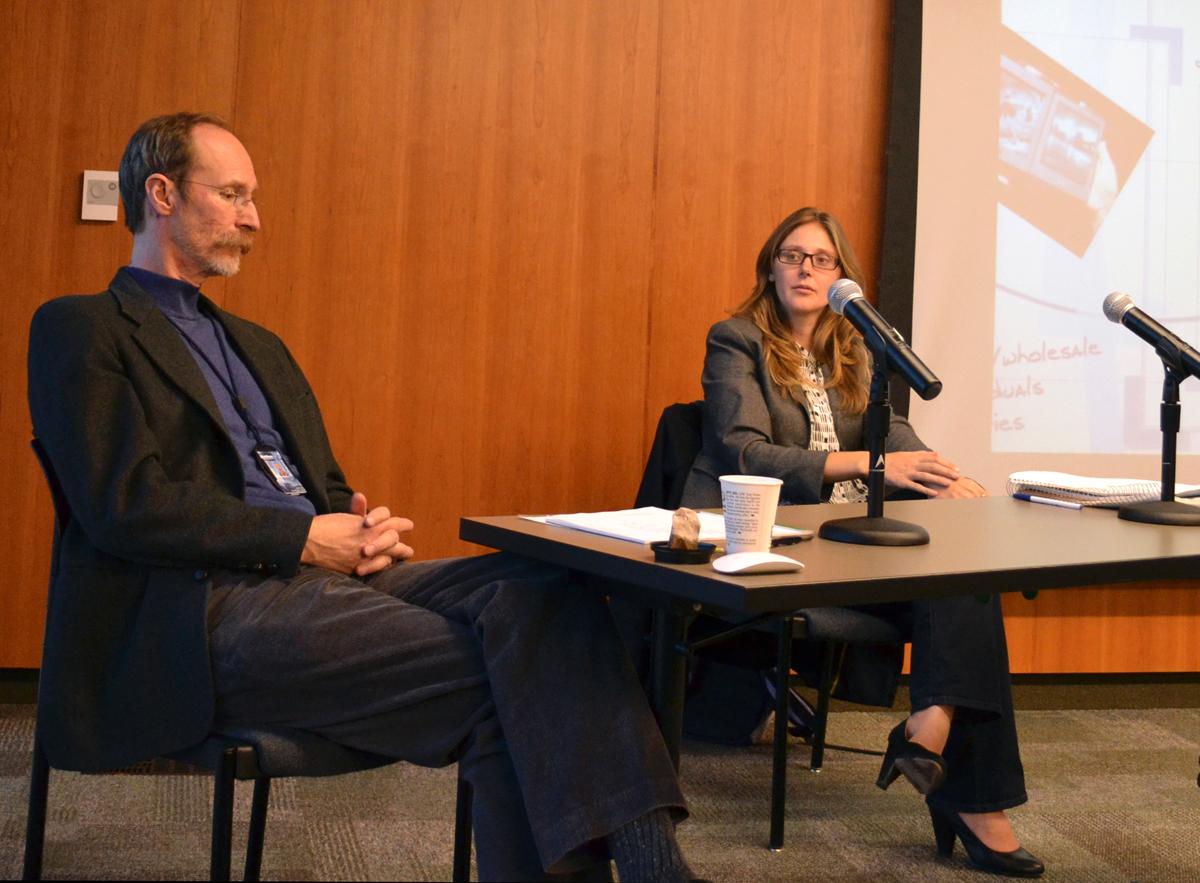Librarians inform public of access rights
The public’s right to knowledge, along with the process and limitations through which people can obtain knowledge through academic journals, was discussed by a panel Wednesday.
Members of the Cache community came together for International Open Access Week to discuss reasons to take action on the issue of open records access.
Open access means “the removal of price barriers, specifically to end-users or consumers of the information,” according to Scholarly Communications and Institutional Repository librarian Andrew Wesolek, who was a member of the panel.
“USU actually really pushes for open access year round,” he said. “Our digital commons pushes to make the intellectual capital of the university — the publications, great literature — available publicly when possible.”
The panel included ethicist Erica Holberg, physicist Charlie Torre and USU Press Director Michael Spooner. Each presented several points regarding rights to knowledge and why valuable research tools should be made available to the public.
“Knowledge is essentially social,” Holberg said. “The ideal that open access is getting right is that ideal of knowledge as good in itself. I think there is no such thing as private knowledge. It happens together.”
“As far as I understand it (open access) seems right to me,” Crystal Larsen, a freshman studying English, said. “It seems kind of incongruent that there wouldn’t be something inaccessible that individuals were paying for.”
Students are losing access to essential academic research that is necessary to complete their educations, according to a statement on the Right to Research Coalition website. Over the last two decades the price of subscriptions to academic journals has increased enormously, to the point where the publications are often out of reach for students, even at the most well-funded institutions, according to the statement.
The site reports that many journal subscriptions cost more than $10,000 per year, and libraries cannot afford to have access to them all. One example is Massachusettes Institute of Technology, which the coalition stated had to increase its journal budget by more than 360 percent over 20 years, to keep up with journal price increases.
“Everything costs, but who should pay?” Torre asked.
It essentially all comes down to economics, Spooner said. People want things for free, but the cost has to come from somewhere.
“If the users don’t want to pay for it, then the authors have to pay for it. They want tenure,” he said. “In order to advance in your career you have to publish in a peer-reviewed venue.”
The Research Coalition reported that because of this publishers take advantage, being sole points of access for these journals. An article can only be published in one journal.
Students and professors need as much access to academic records as possible in order to effectively conduct research, according to the coalition. Because of this need, libraries will subscribe to journals no matter what the price — until funds are depleted.
“This is called monopoly capitalism,” Spooner said, “They’ll publish books and textbooks, and jack the prices up on those as well.”
“Is it possible to have free open access to research results?” Torre asked. “Definitely. It’s already happening.”
Torre displayed the archives for Cornell University, which he said currently has open access to more than 710,000 electronic prints in various fields such as physics, mathematics, computer science, biology and finance.
“There is constant positive pressure for this thing to grow,” Torre said.
He said the archives are essentially an online database to which articles are submitted prior to publication. Anyone can look at them for free, and roughly 7,000 articles per month are now submitted worldwide, he said.
“It dwarfs any collection of journals you can come up with,” Torre said. “More people use this than journals combined. This is what we use when we want to do science. This is how we communicate. It’s no worse than a research journal.”
The bulk of these papers end up getting published in journals somewhere, he said. If you subscribed to all of these articles in journals, you would be paying a lot more.
“The publication process is kind of a screening process for determining what is of scholarly value and what is not. Right now this is the only screening process in place,” said Wesolek, “Professors have to publish in peer-reviewed journals in order to demonstrate that they are contributing to the scholarly community and contributing to the advancement of knowledge.”
Torre said the idea is to use the power of the archives to completely redesign the process of disseminating knowledge.
“The mission of the university is to create knowledge, that’s what we’re here for,” Spooner said. “We create knowledge, and we disseminate knowledge. I don’t know if we have a right to knowledge or a right to unrestricted access to knowledge. What I know is that we live in a finite ecosystem under competing pressures. It’s something that will be to our advantage to work together to solve, but in any case, however, we’re all in it together.”
– amber.murdoch@aggiemail.usu.edu

NATIONAL OPEN ACCESS WEEK is held every year to inform the public of its right to information access, including academic journals. USU faculty try to make as much information accessible to the public as possible, despite high costs to the universty. BRANDON FONDA photo

